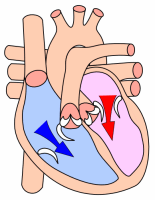Diastole
Diastole (pronounced /daɪˈæstəliː/) is the time during a heart beat when the heart fills with blood after a contraction. The contraction of the heart is called systole and is the opposite of diastole. The term diastole comes from the Greek word διαστολη. This means expanding or opening.[1]

Inside the heart change
There are two types of diastole.
- Ventricular diastole is the time when the two lower chambers of the heart called the ventricles are relaxing to let the blood to flow in.
- Atrial diastole is the time when the two upper chambers of the heart called the atria are relaxing to allow the blood to flow in.
During ventricular diastole, the pressure in the (left and right) ventricles drops. When the pressure in the left ventricle becomes lower than the pressure in the left atrium, the mitral valve opens. The blood then flows from the atrium into the ventricle. The speed at which the blood flows into the ventricles can be used to diagnose diastolic dysfunction.[2]
Diastolic pressure change
Because the heart relaxes during diastole, "diastolic pressure" is the lowest pressure within the arterial blood stream during each heart beat. The highest arterial pressure happens when the heart muscle contracts, and is called systolic pressure.
When blood pressure is measured for medical purposes, diastolic pressure is the second number in the "ratio" of systolic to diastolic pressure; for example: 120/80.
Related pages change
References change
- ↑ Diastole. Merriam-Webster Online Dictionary. 24 August 2008.
- ↑ [1] Abdul Latif Mohamed, Jun Yong, Jamil Masiyati, Lee Lim, Sze Chec Tee. The Prevalence Of Diastolic Dysfunction In Patients With Hypertension Referred For Echocardiographic Assessment of Left Ventricular Function. Malaysian Journal of Medical Sciences, Vol. 11, No. 1, January 2004, pp. 66-74
Other websites change
- Auscultation of Diastolic Murmurs Archived 2011-06-15 at the Wayback Machine
- Audio Examples of Heart and Lung Sounds Archived 2020-12-15 at the Wayback Machine